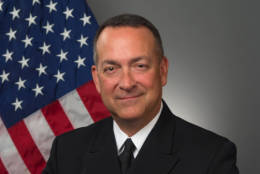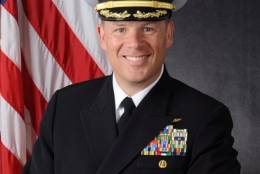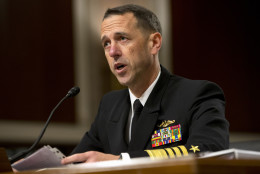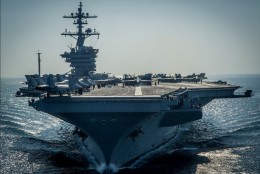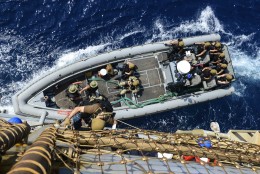Navy
-
In today's #FedFeed, Secretary of State John Kerry visits Vatican City and the Tennessee National Guard takes on a forest fire.
December 02, 2016 -
The Navy is trying to personalize health care for its patients by integrating it in their daily lives.
December 01, 2016 -
When Rear Adm. Matt Winter, outgoing Chief of Naval Research, looks back on his career at the Office of Naval Research, the thing he is most proud of is working with "the best and brightest scientists in the world."
November 21, 2016 -
Rear Adm. Mat Winter, the chief of naval research, is packing up knick-knacks. This week is Winter's final one on the job. He’s leaving the post on Friday to take a leadership position in the Pentagon’s F-35 program office. Before departing, he spent a few minutes with Federal News Radio’s Jared Serbu on Federal Drive with Tom Temin to talk about his two years as the leader of the Office of the Naval Research, which, by the way, turned 70-years old this year.
November 16, 2016 -
Welcome to the #FedFeed, a daily collection of federal ephemera gathered from social media and presented for your enjoyment.
November 02, 2016 -
For the Navy, virtual reality is more than a training tool. It's also becoming a novel way of public outreach. The Recuiting Command plans to field trailer-sized virtual reality chambers to let citizens experience a real-life Navy Seal operation. Capt. Dave Bouve, the national director of Navy Marketing and Advertising. He talked about the VR project on Federal Drive with Tom Temin.
October 26, 2016 -
The Chief of Naval Operations is in charge of manning, training and equipping the Navy. And Adm. John Richardson, the current CNO, says that means civilians too. In a bit of an unusual step for a military service chief, Richardson issued his own framework for improving the health of the civilian workforce on Friday.
October 19, 2016 -
Welcome to the #FedFeed, a daily collection of federal ephemera gathered from social media and presented for your enjoyment.
October 13, 2016 -
The crucial partnership on military basics between the Defense Department and Congress is badly frayed, and the military will be the worse for it.
October 13, 2016 -
The Navy is stuck somewhere back in the Cold Car or maybe World War II. In order to properly equip with new ships, the Navy must change. Bryan McGrath, managing director of the Ferry Bridge Group, Joins Federal Drive with Tom Temin with the whys and hows.
October 07, 2016 -
Saying it’s seeking more inclusion and a broader range of experience within its enlisted ranks, the Navy is moving ahead with the latest in a series of changes to its personnel system.
October 03, 2016 -
Rob Foster, the Department of Navy’s chief information officer, released a new guidance to accept more certifications and qualifications from sailors, seamen and civilians instead of the one-size fits all approach.
September 09, 2016 -
Welcome to the #FedFeed, a daily collection of federal ephemera collected from social media and presented for your enjoyment.
September 08, 2016 -
Perseverance may sometimes look crazy, but it depends on why you push.
August 30, 2016 -
Diving in the Navy rarely involves clear, blue water, sunlight and admiring the skates. It's mostly in the dark, and in dangerous environments. To help divers see, do more work and work more safely, the Navy is developing special equipment placed inside a diver's helmet. Dennis Gallagher, program manager at the Naval Surface Warfare Center's Panama City Division, joined Federal Drive with Tom Temin to talk about the new gear.
August 25, 2016



